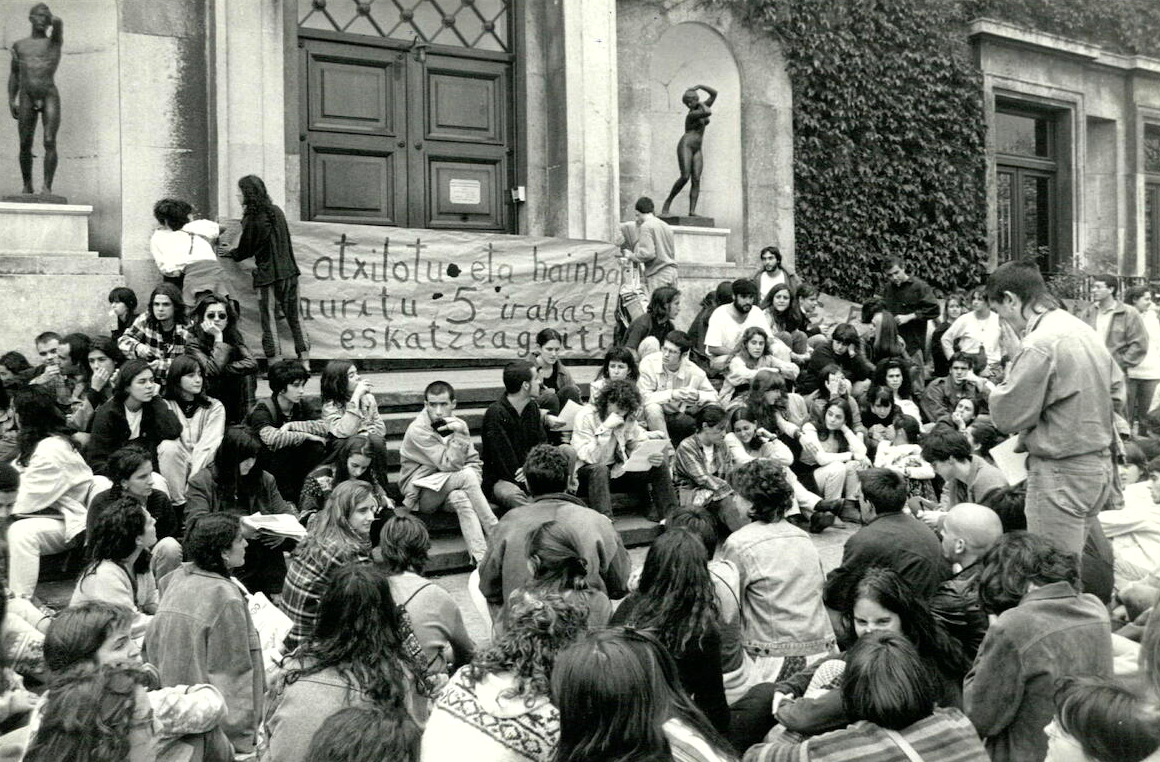
- In 1994, the students of Fine Arts from the University of the Basque Country took part in a memorable struggle. Hundreds of students mobilized for one simple reason: they wanted to learn Basque. Joseba Parrón and Oier Etxeberria tell us what they lived at that time, that they remember those days and activities very well, and that, like Korrika, it was a festive claim. The strike to obtain five Euskaldunes professors took place for three months, during which he occupied the Faculty of Fine Arts. They enjoyed broad support from Basque society, but they also suffered police repression, such as the arrest of several students for occupying the Museum of Fine Arts in Bilbao.

Joseba Parrón and Oier Etxeberria did not hesitate to fight for the Basque in the 1990s: “Our demand was absolutely basic and reasonable. It is incomprehensible that Euskera classes are not taught at the Basque university”. Five professors from Euskaldunes, that was the concrete demand of the students of Fine Arts from the Leioa campus. Both were registered in the Basque branch, but they would not have been able to graduate in Euskera had it not been for the fight they have conducted. After several months, they managed to get the University of the Basque Country to hire these five professors. However, more than an achievement, they remember what they learned along the way.

It wasn't just any path. “Being of Fine Arts, the way we made our demands was very free, joyful and festive.” When they realized that they were made deaf by the formal way, they organized themselves among the students and performed various activities to demand the Euskaldunization of the school. To begin with, they began with an indefinite strike and turned the school into their home, occupied by the two teams. About 200 people lived in Fine Arts School, and about 700 students met in an assembly called Assembly, “without acronyms.” The entire Faculty coincided with the cry, also those of the Castilian branch.
They wanted to claim in a cheerful but at the same time blunt environment.
Parron and Etxeberria look at this coexistence with nostalgia: “We created a utopian space, we made new relationships and it was a tremendous education for all.” They achieved what is difficult to see today, that is to say, to put people of different opinions and ideologies to dialogue in the House, in the face. “You could be a Patriot Student, of the PNV, an anarchist… we all participated freely and nobody silenced anyone,” they remember.
They also claim that the discussions were as endless as the strike, with no solutions. “We felt they weren’t effective, but it was great to share opinions without further purpose.” They recognize that everything began with the theme of the Basque Country, but that behind it they had many other lessons: art, mutual care, self-education, ways of studying and teaching in the university… As the strike continued, they began to organize alternative classes, and each offered courses and round tables on what they knew.

Endless ways to claim the Basque
Works by Fine Arts students have rarely been carried out in the 1990s, and Parron and Etxeberria are aware of this: “We were able to think about anything.” In 1994 he took the fight of the strongest students, but since last year the Euskera Commission of the faculty had begun to mobilize. They did all kinds of activities, claiming the Basque: “Performances, a massive concert on campus, covering the faculty with paper, disguising…”. However, they have acknowledged that it was difficult, as the demands were wanted to be made in a joyful but at the same time blunt environment.
.jpg)
They also remember bigger actions. When they got on a crane in Bilbao, when they walked all morning in the zebra crossing and occupied the Museum of Fine Arts in Bilbao. With the help of the museum workers, they managed to hang a banner in which five Euskaldunes professors were requested, but were severely repressed by the police, who arrested several students. At the Bilbao demonstration, the Ertzaintza also charged them and the workers of the MANIFESTATION.
.jpg)
The road, the most valuable achievement
They decided to end the strike for a number of reasons. On the one hand, because people were tired of the lack of exits and, on the other, because the struggle had spread to all faculties. What started in the Fine Arts became a cry from the entire university; they wanted to euskaldunize the university. Therefore, in Vitoria-Gasteiz a great demonstration was held and soon the missing Euskaldunes professors were hired, in addition to the five Fine Arts professors, to which a further 80 were added. “We don’t celebrate it!” they noticed. In fact, the starting point was the hiring of teachers, but the clamour was much deeper. The key and achievement of the students was to undertake. And society responded to this action, giving ample support and importance; professors, students, Euskaldunes and erdaldun.
“We got empathy easily, because everyone saw that it was the center of our protests to be able to learn, in Basque.” The students of Fine Arts managed to sign a manifesto in their favor, Chillida and Oteiza, placing the names of both next to each other. The students were able to bring together the two angry artists. And the Basque.
